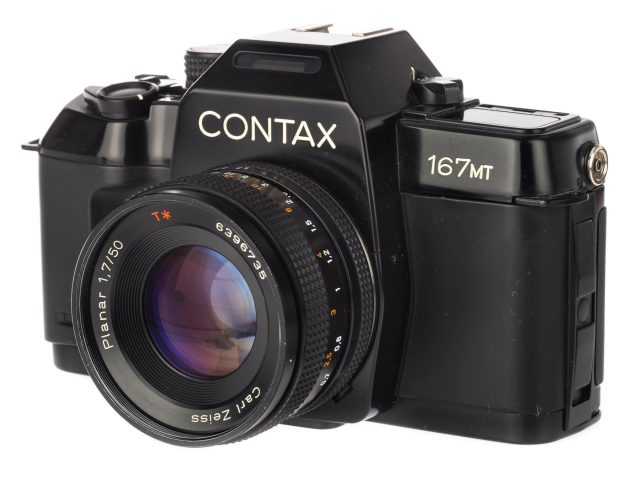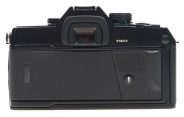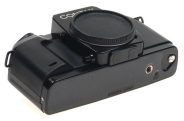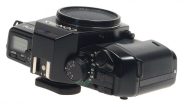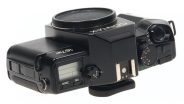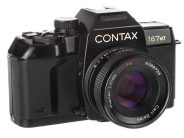Announced
Production status
System
Contax/Yashica system cameras
- Contax 137 MA Quartz
- Contax 137 MD Quartz
- Contax 139 Quartz
- Contax 159 MM
- Contax 167 MT
- Contax Aria
- Contax AX
- Contax Preview
- Contax RTS
- Contax RTS II Quartz
- Contax RTS III
- Contax RX
- Contax RX II
- Contax S2
- Contax S2b
- Contax ST
- Yashica 107 Multi Program
- Yashica 108 Multi Program
- Yashica 109 Multi Program
- Yashica FR
- Yashica FR I
- Yashica FR II
- Yashica FX-1
- Yashica FX-103 Program
- Yashica FX-2
- Yashica FX-3
- Yashica FX-3 Super
- Yashica FX-3 Super 2000
- Yashica FX-70 Quartz
- Yashica FX-D Quartz
Contax 167 MT
35mm MF film SLR camera • Discontinued
Specification
| Format: | |
| 35mm full frame | |
Film type: | 135 cartridge-loaded film |
| Contax/Yashica [45.5mm] | |
| Shutter: | |
Type: | Focal-plane |
Model: | Electronically controlled |
Speeds: | 16 - 1/4000 + B |
| Exposure: | |
Exposure metering: | Through-the-lens (TTL), open-aperture |
Exposure modes: | Programmed Auto |
| Aperture-priority Auto | |
| Shutter-priority Auto | |
| Manual | |
| Physical characteristics: | |
Weight: | 620g |
Dimensions: | 149x91.5x51.5mm |
Manufacturer description #1
Photographers have never had it so good when it comes to exposure control. The Contax 167 MT provides all of the functions expected from modern electronic cameras, and it includes the world's first Automatic Bracketing Control. With this feature, three frames can be shot automatically at different exposure values (over-exposed, normal, under-exposed), either continuously or one at a time. The Contax 167 MT also provides a choice of center-weighted or spot metering, exposure compensation and AE lock. All of which can be used in combination. Exposure control ranges from 3-mode programmed exposure to aperture and shutter-priority, even manual control. And the 2-motor drive system automatically loads, advances and rewinds the film. Leaving the photographer completely free to concentrate on the job at hand.
The Contax 167 MT is also equipped with Carl Zeiss T*(T Star) lenses, famous for true-to-life reproduction.
Automatic Bracketing Control
The Contax 167 MT is the first camera ever to offer Automatic Bracketing Control. What does that mean? It's a well known fact that skilled photographers, at some time or other, bracket exposures to assure the best possible results. Now this often necessary but troublesome procedure can be performed automatically.
With one simple lever, three exposures can be made, each at a different setting (overexposure, normal and underexposure). The bracketing range can be varied from ±0.5 EV to ±1.0 EV in the AV mode, and from ±1.0 to ±1.5 EV in the Program and TV modes.
When the Drive Mode Selector is set to "C" and the shutter release is held down, the three exposures will be made in rapid succession, automatically. After that, the camera stops. Three more exposures can then be made by again holding down the release. The Selector can also be set to "S" to make each exposure individually, but in the same sequence of overexposure, normal, underexposure. Either way, fully bracketed shots are obtained without the bother of manually changing exposure values. But the best is still to come.
This function can also be combined with the other modes and functions for an amazing degree of exposure flexibility. For example, the entire bracketing range can also be adjusted 2 full EV values using the Exposure Compensation Dial. Or automatic bracketing can be combined with Spot Metering and AE Lock for really tight control.
ABC Lever/Exposure Compensation Dial
This control provides a wide range of exposure control. The range is 2 full stops in either direction. Sufficient even for severe backlighting. This function can also be combined with automatic bracketing and Spot Metering/AE Lock.
Drive Mode Selector
This control enables rapid changes between continuous and single-frame motor-drive. 3 fps or "S" for instant response with full personal control. This dial also controls the built-in 10-second electronic self-timer
AE Lock
When ambient lighting is especially difficult, you can take spot metered readings of subjects, lock in the exposure values, and then shoot with assurance. A great feature for backlit subjects and other difficult situations. For example, when you want the subject to appear off-center (outside the spot metering area) and normal metering would produce incorrect exposure due to differences in lighting between subject and background. Once set, the same exposure value can be used as many times as desired. The AE Lock can only be used with spot metering.
Spot Metering
The built-in spot metering system of the Contax 167 MT provides pinpoint accuracy and more certain results under difficult lighting conditions. For example, backlit subjects can be metered without including the background. Or one particular area can be metered to produce exactly the desired rendering. The microprism collar in the center of the viewfinder shows the approximate area covered by the spot metering system.
Center-weighted Metering
This type of metering is suitable for most subjects. The overall illumination is measured, with emphasis on the center area where the subject will most likely appear The different light intensity values are then averaged to give a reading which produces the best possible overall exposure.
1/4000 SEC.
The shutter developed for the Contax 167 MT features an action-freezing top speed of 1/4000 sec. for what could be called stop and go photography. No matter how fast they go, the Contax 167 MT can stop them. Not only that, the rugged construction and precision electronic control ensure highly consistent shutter speeds throughout the range. So, results are always consistent.
Ten Mode Exposure Control
Aperture priority Mode
This mode is most suitable for jobs where depth-of-field control is important. After the aperture is selected, the camera automatically sets the correct shutter speed. Small apertures can be used for sharp focus throughout the scene. Or, the aperture can be opened up for selective focus. Like people, animals or plants sharply emphasized against the soft, blurred colors of the background. That's all there is to it. The shutter speed range in this mode is 16 sec. to 1/4000 sec
Shutter-speed Priority Mode
When speed is the critical factor, this is the mode to choose. Fast shutter speeds can be selected for quick paced action. And the camera automatically selects the aperture accordingly. The top shutter speed of 1/4000 sec. is able to stop almost any movement. Slow shutter speeds can be used for intended blurring to better express the feeling of movement. Or to allow the diaphragm to stop down for greater depth-of field. If lighting conditions are such that incorrect exposure would result at the set shutter speed, the camera automatically selects the correct shutter speed value.
High-speed Program Mode
This mode is especially useful for shooting moving subjects under rapidly changing light conditions where there is no time to constantly check exposure. Although both shutter speed and aperture are selected automatically in accordance with the built-in program, emphasis is placed on the faster shutter speeds. Exposure values change instantly as light conditions vary for complete freedom to concentrate on the subject.
Program Mode
This mode was designed to give correct exposure quickly and easily under the majority of conditions encountered in normal photography. Both shutter speed and aperture change automatically as light intensity falls and rises. This mode is mainly used in situations where conditions are not particularly difficult.
Low-speed Program Mode
This mode still adjusts exposure values automatically, but is weighted toward smaller apertures and lower shutter speeds. This makes it possible to obtain greater depth-of-field than in the other program modes. Perfect for scenery and still life shots.
Manual Mode
There are some situations where nothing can ever replace the human element. When lighting is especially difficult, or a special effect is the goal, this mode is indispensable because of the full control over all exposure values. Once the mode is set, sliding the Operation Button to one side or the other changes the shutter speeds up or down. The "+" or " -" LED in the viewfinder display flickers until the exposure is correctly set, then both go out. The shutter speed range is 16 sec. to 1/4000 sec. Exposure values can be checked anytime by lightly pressing the release button.
TTL Automatic Flash Exposure
Combined with the Contax TLA 280, the Contax 167 MT provides full TTL (Through-The Lens) automatic flash exposure control. A green LED mark built into the viewfinder lights automatically when the flash unit is charged and ready for action. Automatic flash can be used at all apertures.
Flash Sync Speed
In all of the auto exposure modes, the Contax 167 MT automatically sets the flash sync shutter speed to 1/125 sec. when one of the TLA flashes is connected and fully charged. The LED mark lights to indicate that the flash is charged, and the 1/125 sec. display (125) flashes when overexposure will result.
In the manual mode, flash sync is possible at any shutter speed up to 1/125 sec. for highly effective daylight sync. When set to a speed faster than 1/125 sec. the shutter will automatically be reset to 1/125 sec. when the flash unit is fully charged.
Using AE Lock and Exposure Compensation
Applying the AE Lock at flash sync speeds slower than 1/125 sec. will lock in that speed until released. When the camera is set to a shutter speed faster than 1/125 sec., both the flash sync speed and the AE Lock will automatically be reset to 1/125 sec. as soon as the flash is fully charged. Dark backgrounds can be avoided in flash photographs by metering the background and using the AE Lock, then using the flash to illuminate the subject.
After the AE Lock is applied, the Exposure Compensation Dial can also be used to fine tune flash exposures.
TLA Flash System
When mounted on the Contax 167 MT and set to the TTL Auto mode, the TLA 280 provides fully automatic flash exposure. A fast acting behind-the-mirror SPD cell in the Contax 167 MT measures the light reflected directly from the surface of the film for instantaneously accurate flash exposures. Multi-flash and extension flash accessories are available.
Program Mode (using AE Lock, TLA Flash)
1. Above EV11
When the AE Lock is applied and the flash is fully charged the shutter is automatically reset to 1/125 sec and the aperture is reset to the relevant value on the same EV line The "125" display in the viewfinder will flicker if overexposure occur at 1/125 sec and f/16 (B ~ B)
2. At EV11
None of the exposure values will change when the AE Lock is applied and the flash is fully charged
3. Below EV11
When the AE Lock is applied and the flash is fully charged, the aperture is automatically reset to f/4 and the shutter speed is reset to the relevant value on the same EV line.
A New Dimension in Body Design!
The body of the Contax 167 MT is the kind you love to handle. From the hand filling shape to the convenient layout of the controls, here is a new dimension in body styling.
You will immediately appreciate the sleek overall design. With an easy-to-hold grip for extra security and easier, steadier camera holding. And modern push-button controls for quick, easy setting of shutter speeds, modes and other important values. With the easy-to-read external display panel and viewfinder display of all necessary information, you always know exactly what is going on.
External Display Panel
The external LCD display panel provides a large, highly legible display of the mode being used, shutter speeds, apertures, number of exposed frames and the ISO film speed when the ISO button is pressed. This display is also used for the self-timer and for timing ultra long exposures.
Main Switch
The main switch turns the camera power supply on and off. It also serves as the Center-weighted/Spot Metering switch and the AE Lock switch. The functions are selected merely by moving the switch to the desired position.
Mode Button
Pressing this button and sliding the Operation control left or right quickly selects any exposure mode. (TV, AV, Manual, High Speed, Automatic DX-coded Film Speed Setting)
When DX-coded film cassettes are used, the Contax 167 MT automatically senses the film speed rating and sets the exposure system accordingly. Film speed can also be set manually for non-DX films.
ISO Button
This button is used to confirm film speed, and to manually set film speeds when DX film is not being used. When this button and the Mode button are pressed, the film speed (25-5000) and ISO mark are shown at the position normally occupied by the shutter speed.
Battery Check
To check the battery, turn on the Main Switch and then press the Mode Switch and ISO Button at the same time. If all displays on the external display panel light, the battery voltage is normal. The display flashes when the voltage is low.
Viewfinder Display
A light touch of the shutter release button turns on the internal viewfinder display of relevant information anytime. A "P" mark indicates when a program mode is being used. The shutter speed and aperture settings are shown in all modes, together with indication of whether center-weighted or spot metering is being used. Even the number of exposed frames and flash-ready status are displayed. "+" or " _" marks also appear to indicate whether positive or negative exposure compensation is being used. And all displays are clearly visible even at night.
Film Counter
Built into the External Display Panel, this counter shows the number of exposed frames (up to 39) during normal operation. When the self timer is used, however, the remaining time (0-10 sec.) is shown. Bulb exposure times are also counted up to 30 sec., after which the 30 sec. cycle can be repeated as many times as required.
Drive Mode/Self Timer Selector
This dial is used to select continuous (C) or single-frame (S) motor-drive operation. At the "C" position, the camera will continue making exposures at 3 fps as long as the release button is pressed. At the "S" position, one exposure is made each time the release is pressed. This dial is also used to select the Self Timer
Long (Bulb) Exposures
In addition to metered exposures of up to 16 seconds, a Bulb setting is also provided for ultra-long exposures. Exposures times of up to 30 sec. can be displayed. For longer exposures, the 30-sec. cycle can be repeated as often as required.
Auto Rewind Button
This button activates the rewind motor to quickly and automatically rewind the exposed film back into the cassette. When the film has been rewound, the motor automatically stops.
The Basis of Reliability and Precision
Two-motor System
A two-motor system is used in the Contax 167 MT. One motor auto-loads and advances the film, resets the mirror and aperture, and sets the shutter after each exposure. The other motor is used exclusively to rewind the film. When the film has been rewound, this motor backs up slightly to release tension so the film cassette can be more easily removed. The two-motor system results in simpler, more reliable construction, and higher durability.
Exposure Metering Range
Better than words could ever tell, the chart on the right shows the exposure metering range of the Contax 167 MT for various film sensitivities. The relationship between aperture, shutter speed and EV values is also shown, so it is possible to determine the EV range for any lens used with any particular film.
Vertical Travel Focal Plane Shutter
The heart of any camera body is the shutter and the Contax 167 MT is equipped with one of the best. This vertical travel, metal-blade shutter is lightweight yet sturdy enough to withstand the rigors of professional usage. The precision construction and electronic control deliver shutter speeds of extreme accuracy and consistency. The advanced engineering of this shutter has also made possible a top speed of 1/4000 sec. - the ultimate in action-stopping capability.
CMOS LSI Circuitry
The electronic circuitry of the Contax 167 MT centers around a digital LSI CMOS CPU microprocessor, and a quartz crystal oscillator which accurately controls the timing of all operations. In addition, there are separate ICs for exposure metering, internal interfaces and the calculation of values.
SPD Exposure Metering System
The Contax 167 MT uses SPD (Silicon Photo Diode) cells in its exposure metering system. Famous for fast, accurate response, these cells ensure the ultimate in exposure accuracy.
One cell is located in the pentaprism to measure the light from the scene as viewed. This cell is used for both center-weighted and spot metering. Another cell, embedded in the mirror box, measures the light reflected from the film surface for highly accurate, consistent automatic flash exposures.
Aluminum Alloy Diecast Body
Reliability and precision are key words for skilled, hardworking photographers. A camera is useless to such people unless it can deliver consistent performance day in and day out. To fill such needs, the Contax 167 MT is built around a rugged, heavy-duty aluminum alloy body casting which provides a solid anchor for all other mechanisms.
Contax Data Back D-7
The Contax D-7 Data Back can be quickly and easily installed in place of the camera back. The built-in digital LCD and quartz clock and calendar provide a variety of functions. Virtually all of the characters found on a typewriter keyboard can be used to enter the year (to 2079), month, day, hour and minute. The date or the time, or both together, can be recorded on photographs. And five separate 10-character messages can also be stored and used, with or without the date or time. When not needed, the D-7 can simply be turned off. Two lithium batteries provide power for up to three years.
There is also an intervalometer function which can make up to 99 exposures at intervals of up to 100 hours. Starting times can be set in minutes, hours, days and months.
Battery Holder P- 5
The optional Battery Holder P-5 holds four AA batteries to deliver extra power for tough conditions such as cold weather photography. Or extended shooting sessions. There is also a connector for the optional Contax P-6 Power Pack.
Diopter Lenses and Eye-cup
To ensure clear vision, 8 different FL type diopter lenses are available in a variety of strengths. The F-3 eye-cup also clips on firmly to hold the diopter lenses in place, and helps to prevent the entry of extraneous light. The eye-cup can be used with or without the diopter lenses. The back cover can be opened and closed with the eye-cup in place.
Magnifier F-2
This rotating, hinged magnifier provides a magnification ratio of 2.1X for critical work. The 4 element, 2-group configuration also helps to cut peripheral flare. Use is possible with the Data Back or a flash unit installed. And the camera is protected from scratches when the magnifier is used.
Macrophotography Accessories
The many Contax macrophotography accessories available for the Contax 167 MT include the Auto Bellows PC Set, Slide Copier, Macro Stand and Carl Zeiss T * lenses specially designed for close-up applications.
Other Close-up Attachments Contax Right-angle Finder, Contax Cable Switches (4 types), Contax Auto Extension Tube Set, Yashica Microscope Adapter, Yashica and Copy Stand.
Manufacturer description #2
Type: 35 mm SLR featuring Auto/Manual exposure modes and focal-plane shutter
Pictures Size: 24 x 36 mm
Lens Mount: Contax/Yashica mount
Shutter: Electronic vertical-travel metal focal-plane shutter (quartz controlled)
Shutter Speeds: 1/4000 to 16 sec. in auto mode; 1/4000 to 16 sec., and "bulb" (B) in manual mode
Self-timer: Quartz-controlled electronic self-timer with 10-sec. delay; blinking operation indicator LED; exposure counter counts down from 10 to indicate remaining time (sec.)
Shutter Release: Electromagnetic release with cable release socket
Exposure Control: Exposure mode is set with operating lever while pressing mode button. Exposure modes: (1) Standard programmed auto exposure; (2) Programmed high-speed auto exposure; (3) Programmed low-speed auto exposure; (4) Shutter-priority auto exposure; (5) Aperture-priority auto exposure; (6) Manual exposure; (7) Programmed TTL auto-flash; (8) Aperture-priority TTL auto-flash; (9) Manual type TTL auto-flash; (10) Manual flash
Metering System: TTL center-weighted metering/TTL spot metering (spot metering LCD turns on in viewfinder in case of spot metering); TTL center-weighted direct light metering with TLA system flash; SPD (silicon photo diode) cell.
Metering Range: EV 0 - EV 20 with f1.4 lens (ISO 100)
Film speed range: ISO 25 - 5000 in DX auto mode, ISO 6 - 6400 in manual mode; film speed seting is displayed in display panel by pressing ISO button
Flash Synchronization: X contact only; as soon as flash is fully charged, shutter speed automatically switches to 1/125 sec. with dedicated flash; flash synchronization at 1/125 sec. or slower in manual mode
AE Lock: Quantity of light on subject is stored in memory
Exposure Compensation: +2 ~ -2 EV (click stops in 1/3-EV steps)
Automatic Continuous Exposure Compensation: Via compensation value setting lever
Viewfinder: Pentaprism eye-level finder (long eye-point type); 95% field of view, 0.82X magnification (with 50 mm lens at infinity).
Focusing Screen: Standard horizontal split-image/microprism screen; interchangeable screens available
Display in Viewfinder: Exposure compensation, shutter speed /film speed, aperture, exposure counter (also displays elapsed time in bulb exposure and remaining time in self-timer shots), spot metering mark, program mode, flash symbol.
Display Panel: Shutter-speed/film speed, aperture, exposure counter (also displays elapsed time in bulb exposure and remaining time in self-timer shots), shooting modes (Tv, Av, M, PROGRAM, HIGH, LOW), ISO speed, film rewind mark
Film Winding: Automatic film loading with micromotor; automatic film advance; automatic film positioning on exposure counter "01"
Film Rewind: Automatic rewinding with rewind release button and rewind switch; automatic stop when rewinding is completed, film can be rewound in mid-roll
Exposure Counter: Automatic reset, additive counter displayed in both display panel and viewfinder; shutter operates at 1/125 sec. until film advances to "01"
Accessory Shoe: Direct X-contact hot shoe (provided with TLA flash contact)
Drive Mode: Single frame, continuous and self-timer shooting switchable with drive mode selector; continuous shooting up to 3 frames/sec
Camera Back: Can be opened by camera back release lever; detachable; provided with film check window and film transport signal.
Power Source: Four 1.5 V AAA-size batteries. Built-in lithium backup battery for memory protection
Battery Check: By pressing ISO button and mode button at the same time
Battery Capacity: About 50 rolls of 24-exposure film (with AAA-size alkaline-manganese batteries at normal temperature; according to Contax testing conditions)
Other: Aperture stop-down button, contact for data back
***
This sophisticated auto-exposure SLR camera features a multi-mode system which is digitally controlled by a high-performance CPU. Designed with the latest in camera and electronic technology, it offers you a number of outstanding features such as multi-mode exposure control including programmed auto exposure, spot metering capability, and ultra-fast 1/4000 sec. shutter speed. It also provides a large-size display panel to let you check the camera operation and shooting information in the outside of the viewfinder. In addition, there are many features that are designed to facilitate your picture-taking and allow you to shoot in any situation.
From the editor
Introduced at Photokina 1986.
